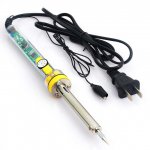Yes, everyone is able to exchange a power cord or a speaker cable. No special knowledge or critical thinking needed.
What about changing the wire from the speaker frame to the voice coil to something more exotic and expensive?
And THAT´s the point, including this very own thread.Cables must be a good high margin biz - 20 of 64 pages in the Spring Audio Advisor catalog are devoted to cables!
And "designing" 😕 Audio cable is EASY, since Audio has such forgiving and easy to meet constraints, with the absolute worst being low level high impedance signals where capacitance is a problem and poor shielding may let outside noise in.
That said, basic principles are known and established for many decades now (if not a Century) so not much expectation for groundbreaking advancements.
Yet the "papers" linked to justify this thread try to SCARE us with a nonexisting problem and offering us an (EXPENSIVE) non Solution.
So within the 20Hz to 20kHz Audio band "difference in propagation velocity" makes standard cables unusable and we need to fork out $2400 for the "advanced/magical" ones?
If that were a real problem, then transmission of Video signals with their almost DC to 4 or 5 MHz bandwidth by cable would be IMPOSSIBLE or at least unusable.
Now .... is it? 😎
So if Walmart can sell you a 250ft roll of coaxial cable for $18 and which definitely works with Audio signals, then *real good* Audio coax must be available for ... what? 5x the price? ... 10 X the price? ..... still orders of magnitude away from "Audiophile" cable prices.
Even easier on Speaker cable, where basically copper section and length rule.
Rules which also apply to "magic" cable unless it can prove to be made of superconducting material.
But, does Belden back up all this?
Not really.
I just searched Belden.com with the "Iconoclast" keyword and they don´t seem to even know about it, no datasheet offered, nothing.
Closest is 1 (one) misspelled 😕 mention in a list of products *using* one or more Belden patents ... not the same.
And "papers" linked to above show clumsily written stuff with a mishmash of out of context Math and Physics , cut and paste images, low resolution scans and poor pencil drawings 😕
I am worried because they are written on Belden stationery but by somebody else pushing Iconoclast cabling 😱 , don´t look like "Belden documents" AT ALL.
Not sure it´s even legal using Belden stationery and logo to give credibility to "outside" claims, even if that person once worked there.
Which would have made easy to bring home a few sheets of paper from work.
Attachments
Obvious to you, non sense to me.
More non sense about contacts follows.
You must have no experience in RF, I have my license.
Obviously, the only time I could hear a difference in cables was in high frequencies with a weak connection. Bass is not affected by any mean by the contact quality because the signal is too low, a good example is house electricity, with 60-50 hertz there is no significant % of power loss through 0.5 ohm, however at 10 000hertz this is significant as well as AUDIBLE because of the intermittent nature of poor contacts.
RCA is a totally crap connector, the worst in the industry. The worst ones are GOLD plated. A normal nickel RCA does a better job. Gold platting is absolutely the worst type, under the Gold there is a layer of OXIDATION , yes, to plate the gold, Gold to cheap metal conducts very bad, Gold Contacts are not strong to protect the layer from damage by friction too...
Last edited:
… my cable is even cheaper than yours…
My speaker cables were free. 2 strands of 24g solid pulled from a CAT5 cable salvaged from the computer store.
Speaker cables/speakers/amps are a system that has to be considered as a whole. Similarily with other cables. The field is a minfield because of all the snake-oil guys out there, but there are legitimate efforts. Measurements don’t do it, valid listening tests are very hard to do, and hearing acuity plays a huge role in people’s opinions on cable. If not trained it is easy for listeners to miss differences that others clearly hear.
dave
High capacitance speaker wire seems to roll the top off also...to me anyway,ymmv.
Or blow up the amp. We fixed an aweful lot of amps killed by cobra/polk speaker cables.
dave
You must have no experience in RF, I have my license.
RCA is a totally crap connector, the worst in the industry. The worst ones are GOLD plated. A normal nickel RCA does a better job. Gold platting is absolutely the worst type, under the Gold there is a layer of OXIDATION , yes, to plate the gold, Gold to cheap metal conducts very bad, Gold Contacts are not strong to protect the layer from damage by friction too...
I have a family background in amateur radio and engineering. Yep, nickel every single time.
Having made my own cables at £1 per foot, I really don’t see any point in splurging out on fancy cables. Rather spend on new music to listen to.
The concept of line to load match is valid. By dropping z, inductance goes down.
The use of multiple stands in that fashion is a decent thing.
The LC product is consistent with most plastics when used in a field constrained cable, EDC is 2.9
That said, 1600 dollars is ludicrous. To obtain that L and C using some paralleled zips is trivial. It appears he did a limited production run and is trying to recoup the NRE charge. Some vendors also have a minimum run, several quoted me 10kfoot minimums.
Jn
The use of multiple stands in that fashion is a decent thing.
The LC product is consistent with most plastics when used in a field constrained cable, EDC is 2.9
That said, 1600 dollars is ludicrous. To obtain that L and C using some paralleled zips is trivial. It appears he did a limited production run and is trying to recoup the NRE charge. Some vendors also have a minimum run, several quoted me 10kfoot minimums.
Jn
And replaced them withWe fixed an aweful lot of amps killed by cobra/polk speaker cables.
which doubles as a fuse.2 strands of 24g solid pulled from a CAT5 cable salvaged from the computer store.
Well, sure ...IF there is a difference, that is, and not just of the "perceived" type.hearing acuity plays a huge role in people’s opinions on cable.
In my book, IF there is an audible difference,then something must measure different, no way not to.
Current instrumentation is way more sensitive than ears.
In the "old days" , say 50´s and early 60´s (by the way, when I was young 🙁 ), there was not much (if at all) Acoustic measurement equipment available to the general public and even testers/salesmen/even Audio magazine writers, so I got sick and confused reading tons of tests written such as: "we listened to Chopin´s Piano concerto N*1, sound was vibrant but subdued, then to Ella Fitzgerald´s Mack the Knife, where lower registers were xxx , higher ones yyy, brass was warm but sharp ...." and so on and on and on.
Endless descriptions of records and subjective opinions about their sound.
Such tests actually meant little to nothing to somebody not present there so a waste of good paper and ink, and it was a relief when suitable equipment started to spread around, allowing for objective data to be available.
I remember a transition era (think the 70´s) when subjective tests were still relied on, but also many Hi Fi magazines sent equipment to be tested at "mmmmm" Labs, don´t remember name by heart (d*mn Alzheimer🙁) but they were ubiquitous, obviously well equipped and offered their services to Magazines.
I think a couple greybeards around here will remember their name.
Sadly once huge Subjective Opinion world still thrives in some niches ... one of them being Hi Fi Audio.
Not bad, it has its utility, but also leads to discord and confusion if not used carefully.
So much comedies in one thread ... in a collective way. I didn't know collective consciousness exists lols.
Seeing as this is a diy forum has anyone ever fully connected source,amp, and crossover/speaker without connectors (straight solder joints).....and does/would it make a difference?
Which the raises the question - which solder formulation sounds best / more transparent?
Even though there’s more than a smidgen of snake oil / egophile bling to be found in the Cardas catalogue, I’m a fan of the original Quad eutectic, of which a single 1 lb roll can last quite a while.
What I am wondering is what the pf/ft of that ‘amp killer’ Polk wire is....does anyone know?
Wondering for reference
Wondering for reference
Not sure, but I can offer you a transparent soldering iron!Which the raises the question - which solder formulation sounds best / more transparent?
Attachments
has anyone ever fully connected source,amp, and crossover/speaker without connectors (straight solder joints).....and does/would it make a difference?
At a meeting many years ago, I suggested to Monster Cable's "head Monster" that the best speaker wire would be none- speaker terminals attached to the amplifier PCB. Not practical, of course, just to make a point. We had to agree to disagree...
- Status
- Not open for further replies.
- Home
- Member Areas
- The Lounge
- Cables - measurement and listening

